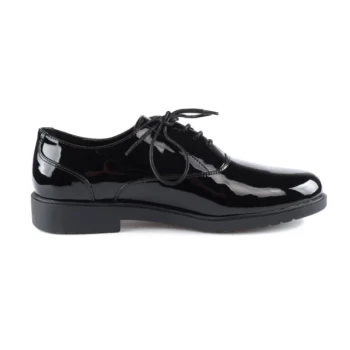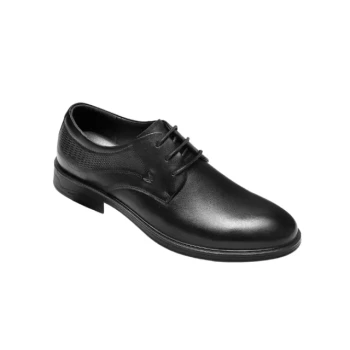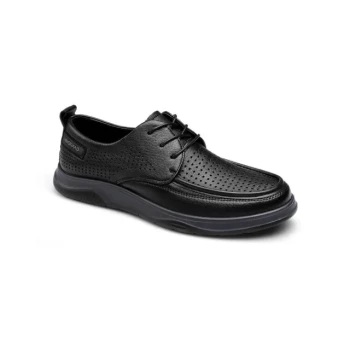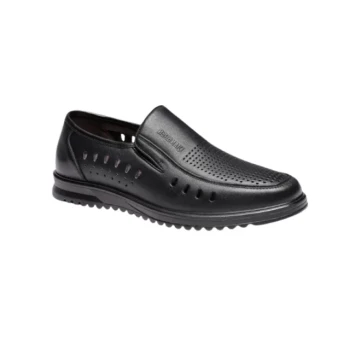A properly fitted dress shoe should feel like a firm, supportive handshake for your foot—not a crushing vise. The fit is defined by three key points: a snug heel with no slippage, about a half-inch of space between your longest toe and the shoe's end, and comfortable accommodation for the widest part of your foot without pinching.
The most critical mistake is assuming a painful "break-in" period is normal. High-quality shoes made from good materials should feel comfortable and supportive from the first wear; significant discomfort indicates a fundamental mismatch between the shoe's shape and your foot.
The Anatomy of a Perfect Fit
Understanding how a shoe should interact with each part of your foot is the key to finding a pair that serves you for years, not just for one event. This goes beyond a simple size number.
The Heel: Your Anchor Point
Your heel should be securely held in place. When you walk, there should be minimal to no slipping.
Excessive heel slippage is a primary cause of blisters and an indicator that the shoe is either too long or the heel counter is the wrong shape for your foot.
The Toebox: Giving Your Toes Room
The rule of thumb is to have about a half-inch (roughly a thumb's width) of space between the tip of your longest toe (which may be your second toe) and the front of the shoe.
This space allows your foot to move forward naturally as you walk, preventing your toes from jamming into the front, which can cause pain and nail damage.
The Width: The Ball of Your Foot
The widest part of your shoe should align with the widest part of your foot, also known as the ball.
You should feel the shoe firmly hugging this area, but it should not be tight or cramping. When you walk, the shoe should flex naturally at this point along with your foot.
The Arch: The Unseen Support
A well-made shoe has a defined arch structure. This should align with the natural arch of your foot, providing support without creating uncomfortable pressure.
If you feel a noticeable gap or excessive pressure in your arch, the shoe is not a good match for your foot's geometry.
"Breaking In" Is a Red Flag, Not a Feature
A common and damaging myth is that good leather dress shoes must be painful to break in. This confuses the natural settling of quality materials with the pain of a poor fit.
The Myth vs. The Reality
High-quality, full-grain leather is supple and will gently mold to the unique shape of your foot over time. This is a subtle conforming process.
Sharp pinching, intense pressure, or pain that makes you want to take the shoes off is not a "break-in" period. It is a clear sign that the shoe is the wrong size, width, or shape for you.
How Construction Impacts Initial Feel
A shoe's construction method directly influences its out-of-the-box flexibility.
Blake stitching creates a very flexible and comfortable shoe from the first wear. Goodyear Welt construction is more rigid initially but offers superior durability and water resistance. Even so, a Goodyear-welted shoe should still fit correctly and not cause actual pain.
Understanding the Trade-offs
Choosing the perfect dress shoe involves balancing several factors. Being aware of these trade-offs is essential for making an informed decision.
Sizing is a Guideline, Not a Law
Your "size 10" is merely a starting point. Sizing differs significantly between brands and even between different shoe styles (e.g., an oxford vs. a loafer) from the same brand.
Always judge a shoe by its fit, not the number printed inside.
Style vs. Foot Shape
Extremely pointed or narrow shoe styles are fashionable but may not be compatible with your natural foot shape.
Forcing your foot into a shoe that is fundamentally the wrong shape will inevitably lead to discomfort and potential foot problems, regardless of how well-made it is.
Durability vs. Immediate Flexibility
As mentioned, a Goodyear-welted shoe is built for longevity and can be resoled multiple times, but it is stiffer at first. A Blake-stitched shoe offers immediate comfort and a sleeker profile but is less water-resistant and may not last as long.
Neither is inherently "better," but they serve different priorities.
Making the Right Choice for Your Feet
Your goal determines which factors to prioritize. Use these guidelines to test your next pair and make a decision based on your specific needs.
- If your primary focus is long-term durability: Seek out a Goodyear-welted shoe from a reputable maker and ensure the initial fit is correct, accepting it will be stiff but not painful.
- If your primary focus is immediate comfort and a sleek profile: A Blake-stitched shoe is an excellent choice, but be prepared for a potentially shorter lifespan.
- If you have wide or hard-to-fit feet: Prioritize brands that offer multiple width options (D, E, EE, etc.) and never compromise on width for the sake of a specific style.
Ultimately, investing in a proper fit is the single most important decision for your comfort, your foot health, and the longevity of your shoes.
Summary Table:
| Key Fit Area | What to Look For | What to Avoid |
|---|---|---|
| Heel | Secure hold with minimal slippage | Excessive up-and-down movement |
| Toe Box | ~1/2 inch of space from longest toe | Toes touching or jamming into the end |
| Width (Ball) | Firm hug at the widest part of your foot | Pinching, tightness, or cramping |
| Arch | Support that aligns with your foot's arch | Noticeable gaps or excessive pressure |
Struggling to Find the Perfect Fit for Your Customers?
As a large-scale manufacturer, 3515 produces a comprehensive range of high-quality dress shoes and boots for distributors, brand owners, and bulk clients. We understand that a proper fit is paramount for customer satisfaction and brand reputation.
Our production capabilities encompass all types of footwear, with a focus on superior materials and construction techniques—from durable Goodyear welting to immediately comfortable Blake stitching—ensuring you receive products that are both well-made and correctly shaped for ultimate comfort from the first wear.
Let us help you provide your customers with shoes that fit perfectly from day one.
Contact our team today to discuss your manufacturing needs and how we can support your business.
Related Products
- Custom Manufactured Air Cushion Leather Business Shoes for Wholesale
- Wholesale Comfortable Business Casual Shoes Custom Manufacturing
- Wholesale Comfort Dress Shoes with Dial Closure for Custom Manufacturing
- Factory Direct Wholesale Leather Comfort Shoes with Dial Closure
- Wholesale Leather Business Casual Shoes with Dial Closure - Manufacturer of Comfort Dress Sneakers
People Also Ask
- How does leather compare to other shoe materials in terms of durability and comfort? A Material Guide for Footwear
- What should be considered when choosing sneakers for a business casual office look? Achieve Comfort & Professionalism
- What are the characteristics of business casual sneakers? Master the Polished & Professional Look
- Are sneakers appropriate for business casual settings? A Guide to Modern Office Footwear
- What are the benefits of calf leather for dress shoes? Unmatched Elegance & Comfort



















